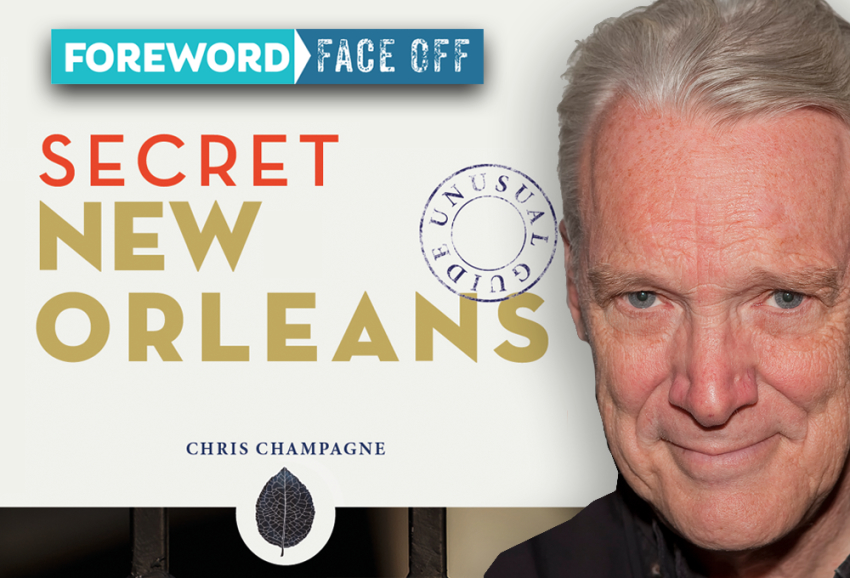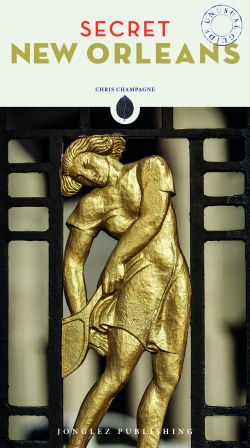Chris Champagne, Author of Secret New Orleans, Spills the Beans on His Favorite N.O. Haunts

An attitude of ’been there, done that’ is a half-baked approach to travel—as if every destination has but a handful of easily doable things to see. In truth, too many travel guides encourage this herd approach by writing about the same natural parks, gardens, amusement parks, restaurants, and other attractions.

Which is why we were so excited to come across Secret New Orleans, a guidebook to dozens of hidden, quirky, uniquely New Orleans-esque haunts of that fascinating city—the largest wind-chime sculpture in the world, for example, or a house made of 1200 ashtrays. We reviewed the book in our Jan/Feb 2018 issue of Foreword Reviews, and, well, we still wanted more so we tracked down Chris Champagne, the eccentric local-boy author of Secret New Orleans, to ask a few open-ended questions via email. We promise, you’ll never think of the city in the same way.
From the earliest days of Spanish and French control, African Americans play a huge role in the history of New Orleans, albeit under the ghastly shadow of slavery in the early centuries. And now, more than two-thirds of the city’s residents are African American—all of which makes New Orleans quite unique in the US. Can you talk about some of your favorite African American themed sites you mention in Secret New Orleans?
African Americans have been part of New Orleans from the start, of course, and have a great impact on our history. The history is somewhat complicated but a good place to start to understand this is at the Musee de f.p.c., a museum dedicated to the Free People Of Color. This beautiful compact museum is an underappreciated resource and tells a story that is misunderstood, if even considered by most of America.
One of my favorite spots in the book is the House Of Dance and Feathers, a unique place that presents a down to earth, playful, and exuberant flavor of New Orleans’ African American experience.
For those who are fascinated with Mardi Gras Indians, the Backstreet Museum lets you experience the beautiful costumes up close, in a leisurely way that you just can’t do at a parade.
Music lovers flock to New Orleans throughout the year. What little known attractions in the city might be of interest to them?
Most famous New Orleans musicians get their fair share of recognition but one of the coolest entries in the book to me pertains to an all but forgotten musician, Basile Bares.
Inside the lobby of the historic Roosevelt Hotel you’ll find a baby grand piano that once belonged to Bares, perhaps the most famous musician in the city in the years following the Civil War. Bares was born a slave and was the first slave to be awarded a copyright for a musical composition by the United States government.
Another offbeat point of interest to music aficionados would be Holt Cemetery, a quaint and poignant potters field where the great jazzman Buddy Bolden is buried in an unmarked grave. This humble yet colorful burial place in Mid City is also the home to occasional voodoo practices.
The Music Box Village in Bywater is an up and coming musical treasure.
J and M Music’s former home, now a laundromat, is arguably home to the creation of rock ‘n’ roll, and the space where Cosimo Matassa recorded Fats Dominos’ first hits and many of the classic rock ‘n’ roll standards, and just across the street from Congo Square, where slaves were allowed to express their creative impulses, including their music, and was certainly a public crucible for the creation of rock ‘n’ roll.
Aside from things to see and do, but using your secret theme, what’s in the character or personality of New Orleans that most visitors don’t realize? In other words, as a lifelong citizen, what is it about the city that you love and value, but may be overlooked or misunderstood?
The thing that always jumps out at me about New Orleans is the human scale and beauty of our older neighborhoods. The stately mansions on St Charles and Esplanade from a bygone time are still lived in. The middle class and more humble homes in Uptown or Marigny and even the Lower Nine have a ethereal beauty architecturally that could never be replicated. This is what I feared would be lost when Katrina flooded most of the city. But this has endured and adds a backdrop of our everyday life that I think we take for granted. I often take side streets on my way to work to soak in the beauty that somehow feed the soul. It’s a residential mosaic that is unique.
The other thing is the verdant nature of the city. From the incredible oak lined boulevards to the gardens this is a very lush city.
One other thing that is misunderstood is that for most Orleanians, Mardi Gras is a family affair. Sure, there is the earthy bacchanal nature of the celebration, and in profusion, but to most of us it goes back to our childhood and the magic tableaux of the masks, the floats, the throws.
We’d be remiss not to talk about New Orleans’ incomparable food scene, drawing as it does from so many influences. How would you encourage a foodie to do New Orleans?
I’m more of a basic guy when it comes to what I eat but, of course, in New Orleans, I suppose the basics are a bit more exotic than in most places in the US.
I’d recommend going to at least one fancy spot like say Antoine’s or Arnaud’s which are both represented in Secret New Orleans, and are museum-like in their own right, especially Antoine’s. Galatoire’s or Commander’s Palace would be two other good choices for a splurge.
Other than that, I’d insist you try a poor boy. This is our signature sandwich. Ask anyone on the street who lives here what their favorite place is and you probably can’t go wrong.
Also I would try to go to neighborhood place outside the Quarter. Liuzza’s By the Track is an unpretentious but fabulous place. Mandina’s down Canal Street, Katie’s in Mid City, Pascal’s Manale, the creator of Bar B Que Shrimp is Uptown, and for oysters, I highly recommend Casamento’s.
But truthfully there are so many really incredible eating spots its almost a shame to narrow it down to a few.
If you have a kitchen at your disposal and have an adventurous streak, go see the Cowan Man, referenced in the book, and get some really exotic fare. Then get a cookbook from Kitchen Witch to find a recipe for that alligator.
And if you can find a crawfish boil by all means indulge. That is a real Louisiana experience.
Alright, let’s give you an opportunity to vent a little, if you want. We all realize hundreds of thousands of tourists a year tend to visit the same handful of famous New Orleans sites. So, what parts of the city would you send them, IF the French Quarter, for instance, didn’t exist?
Get out of the Quarter. Sure, the Quarter is unique and fabulous. Spend a lot of time walking around, eating, drinking—you can bring your cocktail for a walk—listening to music, people watch, admire the architecture. But you can do that in other parts of the city, as well.
Take the streetcars out into the city. They go to the cemeteries down St Charles and to City Park and Bayou St John.
City Park has more than a few attractions in Secret New Orleans and is home to The New Orleans Museum of Art which I recommend highly. Take a walk through the oaks and lagoons of the Park, and check out Morning Call in the heart of the park and have some coffee and chicory and beignets.
If you travel to the places I describe in Secret New Orleans you’d travel to all sections of the city and get to know the real New Orleans in a way you just won’t if you stick to the Quarter,
You have a mind-boggling bio: writer, performer, poet, comedian, political satirist, radio show host, columnist, and, lest we forget, one helluva guy. We don’t want to force you to divulge to many secrets, but where do you go for a night on the town? Best stand-up comedy? Poetry slams? Live theater?
The Frenchmen Street corridor right outside the Quarter has become the go to spot with many music clubs always throbbing and busy. Check out Snug Harbor for some of New Orleans finest musicians and, across the street, the Spotted Cat, with no cover, is always hopping and a lot of fun.
The first few blocks of St Claude Ave. have recently become another hot spot of music and comedy and theater. Places like the Hi Ho Lounge, The Allways Lounge, Siberia, and Cafe Istanbul have interesting entertainment almost every night.
Chickie Wah Wah on Canal Street has great local music every night. The Maple Leaf Bar on Oak street is legendary. Catch the iconic Phillip Melancon at the Bayou Bar—piano bar at its best—also on the streetcar line.
The Sidebar is a new intimate music spot along Tulane Ave. where you can chat up the musicians.
Le Petit Theater in the Quarter has top notch theater. There is regular comedy at Howling Wolf at Comedy Gumbeaux every Thursday and at Lost Love Lounge on Tuesdays. There is a very active burlesque scene on Tuesdays at the Dragon’s Den and the Country Dish Jamboree.
Poetry readings on Sundays at 3:00 pm at the Maple Leaf Bar and on many Wednesday nights at BJ’s Lounge at the Blood Jet Reading Series. Also local featured poets gather every first Saturday at 2:00 pm at the Latter Library at the Poet Buffet hosted by New Orleans poet Gina Ferrara.
Don’t be fooled by the Second Line poisoning. Second Lines are great but they are not the be all and end all of our culture you’d think they were if you happen to go to a photography exhibit in the city. Just do a bit of homework online and in the press and you’ll find a treasure trove of creativity to suit your taste.
Matt Sutherland
